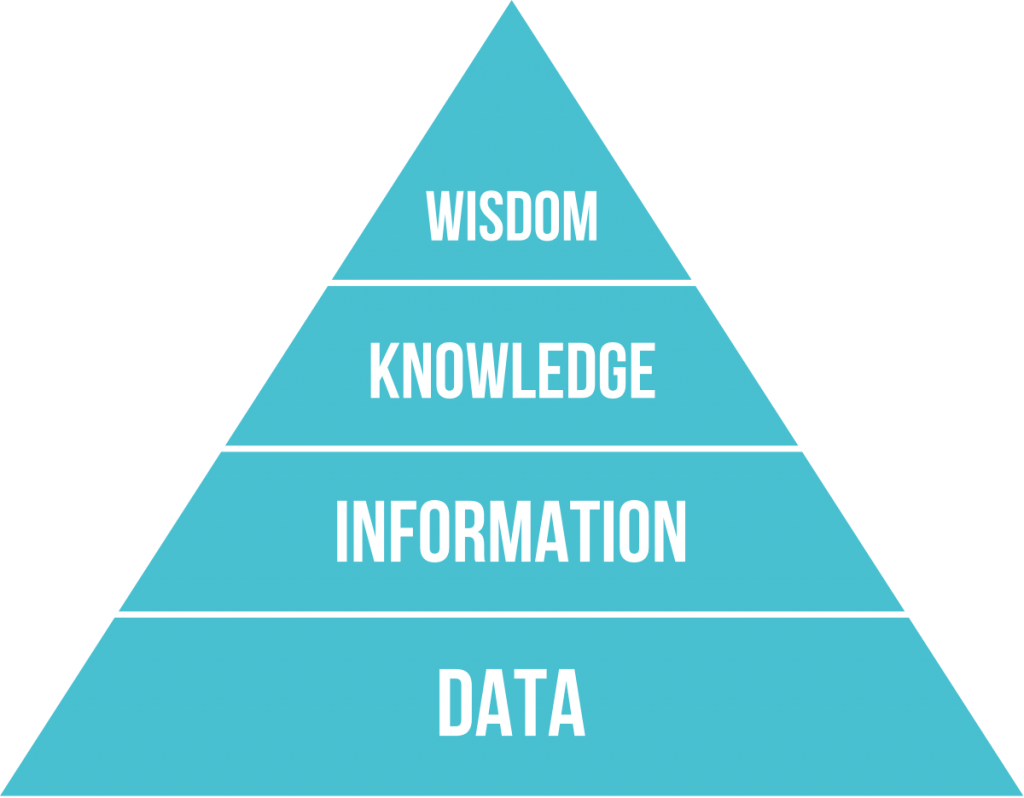
Propagating viral ideas all starts with transferring enthusiasm.
This week I embraced my good fortune in spending a thoughtful two hours in the company of a wise elder, someone I exchange emails with and occasionally meet up with.
Much of our conversation centred around the changing face of university education. Out of this came a powerful insight, not only for education but also for leaders communicating their message.
It takes more than transferring knowledge

You are likely familiar with this concept of layers of learning. Our modern world bombards us with data at a level inconceivable before the age of smartphones and the internet. For years, then, a challenge of educators has been to move beyond downloading data and information to students, to giving them the tools to actually learn, to transfer that data and information into knowledge, then perhaps into wisdom.
My conversation with my learned friend was about the rapid change in how students get information. The days of textbooks and attending lecture after lecture and taking notes of what the lecturer says are (or should) be far, far behind us. All information needed to give to students can be given electronically (whether words, audio, video) and absorbed, much like TV is these days, as and when the student wishes to.
The purpose of lecturing is to transfer enthusiasm
So, then, what is the point of a physical building, a lecture theatre holding 500 students with one person talking to them from the front? According to my wise and learned friend, the answer is simple:
Transfer Enthusiasm
As soon as they said these words, that hit home strongly for me.
They went on to emphasise this by talking about how, if Universities “get” this, they allow those lecturing to bring their own material, stories, flavour to any lecture, not simply read from a structured and approved presentation or, worse, have someone else deliver their material for them rather than taking the time to share it in person with students.
If we start to think of face to face lectures as more like TED Talks, consider how these really work. In a talk of always less than 18 minutes, the presenter shares an idea they are truly passionate about. Success in this means that not that the person watching or listening has taken on board all of the data, information, the knowledge they have delivered.
No, success in a TED Talk is that they have transferred enthusiasm for the idea to the audience.
Now, once we are enthusiastic, consider the internet as a friend of higher education, no longer a challenge.
An enthusiastic student will voraciously seek out information from many sources, and from this, they can considering one definition of wisdom being discernment, of filtering what knowledge matters, what connects, what synergies exist.
Learning Economics at University – a “both/and”
As an example, the evening after the conversation about transferring enthusiasm, I was on a late train home and ended up having a jovial chat with my seatmates. One was a young person who, it turns out, had just finished a Bachelors in Economics and had just started a Masters.
I, rather glibly, initially was negative about the curricula of universities around Economics and how they are often struggling to evolve with new thinking in the field. However, I could see the young student was hugely enthusiastic about the topic, so, as a lifelong student of Economics myself, I simply recommended they take their enthusiasm and study outside and beyond what their university teaches and even what they suggest, to find their own path.
Now, given the workload of such courses, with so much “data and information” being crammed into the students, this student really hadn’t thought about looking beyond the university curriculum, so they asked me for sources of learning.
I could have tried to give some (on a late-night train ride, remember!), but didn’t. Instead, I simply acknowledged them for their enthusiasm and encouraged them to use a “both/and” approach and not only study what they need to for their course, but also be insatiably curious and look anywhere and everywhere for other ideas.
By taking their enthusiasm and a “both/and” approach, students can both embrace the learnings being given to them by Universities and also challenge orthodoxy and be part of encouraging evolution and change in what is taught.
When CEOs Visions fall flat
What, then, can CEO’s learn from the idea of “Transferring Enthusiasm”?
I talked earlier about the value of someone delivering their ideas with a presentation or lecture themselves and not having someone else do it for them, the purpose of this being to transfer enthusiasm for the idea rather than simply transferring data, information, knowledge/
Now, contrast this to the common approach of CEOs, where they create their own vision for the company with, at most, a small team of their senior leadership. They then typically bring in consultants and marketing agencies to create a strategy document and package it, then send it out aross and beyond the company.
All too often, from this approach, I see people in businesses who simply aren’t enthusiastic, they aren’t engaged.
The vision then falls flat and, every 18-24 months, the cycle is repeated.
The power for CEOs of “Transferring Enthusiasm”
So, if the traditional “top-down” way of delivering a vision from the CEO and “HQ” doesn’t work, then what does?
Well, as it so happens, much of my professional work is in supporting leaders with their leadership and so with their vision and with communicating it.
From this work in supporting leaders, let me give you a three-step process for transferring enthusiasm:
- Get on the road
- Keep it simple
- Make sharing easy
Let me give you a real case study.
From “Listening Tour” to “one word” to radical change
Imagine you are leading an organisation with thousands of people and over a hundred offices in a very large country. Oh, and your business is and has been thriving for many decades, so there is no “burning platform for change”. Sometimes you feel that only you see the changing landscape ahead that will necessitate visionary and radical change very soon?
In 2015 I began work with the incoming CEO of a large organisation in Canada. This leader knew, as they prepared to step into their role, that their business needed to have a radical and transformative vision. However, they also knew that to create and sustain such a shift would not be simple or easy, so they retained me to support them in that leadership.
1: Get on the road
My first thought for leaders is to simply get out on the road themselves as much as they possibly can, visit their people, talk to them, listen to them.
A leaders role is to lead, not to manage, so don’t be in your office sending emails and reviewing numbers, get on the road and get in front of people. Engage with people, share your ideas, listen to feedback, iterate, evolve, augment the vision and ideas to incorporate what you learn from that.
I’ve often had clients who have gone from rarely visiting their teams, perhaps just a few “road trips” per year, to then visiting over 40 offices in a year on road trips at least twice a month.
(Returning to the idea of “Transferring enthusiasm”. In business we often call this “engagement” and “alignment”, so key to this transformation was for this leader to get out and talk to people in the business before they had a fully formed vision and strategy, to in fact make everyone in the business part of the process of creating this. For more, see “Cascading Alignment“.)
So, back to our incoming CEO. They knew the core of the vision the business needed on day one, but if they’d simply sat in the corner office at HQ and sent out dictats once they took on their office, very few would have felt enthusiastic.
So, what did we start with? Well, this leader was (and still is!) super-enthusiastic about their business and the transformative vision, so they happily went travelling. Across the Canadian winter, they flew to every province and went to over 40 offices in four months, doing this before they even took on the role of CEO.
We called this a listening tour. They shared their ideas, then listened. Again and again.
What came out of this listening tour?
First, people felt heard, they felt engaged with.
In addition, the vision became distilled to an extreme extent.
2: Keep it simple
When that enthusiastic leader went on their listening tour, they started with a forty-page powerpoint. We’d worked on this at the beginning, and while doing so I set an anchor at that starting point from an old quote:
“If I’d had more time, I’d have written a shorter one”
Every two weeks I would then have the client take time to talk through their latest listening tour stops with me. I’d ask what they had learned on the tour, then they would edit the powerpoint, simplifying it at each iteration.
By the end of the listening tour, the forty page presentation was down to eight pages.
With that output from the listening tour in winter and spring, we then ran a series of offsite meetings across Canada in the early summer for various level of leadership around the vision.
By the end of those meetings, we had the vision down to something very simple. One word.
One word. Keep it simple.
3: Make Sharing Easy
So, in our case study, the leader had first got on the road, then, through that, simplified the message. The third step was then to make sharing easy.
We had simplified the message, the vision down to one word, so now it was time to transfer enthusiasm around that word to the people in the business, then to make sharing the message easy.
Stage one that with the “one word”, three focal points were landed on (each of them being one word), and with that “one-page strategy” we took it to an annual two-day meeting in early Autumn. This was an annual meeting of 500 people across the business, each of them being leaders of offices, teams, sectors etc across the country.
At that meeting, workshops were held involving everyone in defining strategies, projects, actions to be taken around the focal point, both for the business as a whole and for their office, their teams.
Every single person left the two-day meeting with a) enthusiasm for the vision for the company and knowing how to share it both inside and outside the business, as well as b) their own “one-page strategy” to take back to their own team to share and take action from.
So, with those three stages completed (it took about nine months overall), since that point, the CEO has always continued to take time to get on the road and meet people, but it is no longer their idea alone to share.
Once you truly transfer enthusiasm, the idea takes on a life of its own. Everyone who is enthusiastic about it shares it. In internet parlance, it goes viral. Yes, always good to take time to meet your people, share your enthusiasm, but when they get enthusiastic, your presence adds to what is already happening, it is not at the heart of it.
“Nothing is as powerful as an idea whose time has come”
Victor Hugo
However, propagating viral ideas all starts with transferring enthusiasm.
To close, if you have some interest around this but would like to talk 1:1, I’m always happy to share, and perhaps a 1:1 video call will transfer further enthusiasm from me to you.
Let’s talk
Book your 30-minute meeting here.
